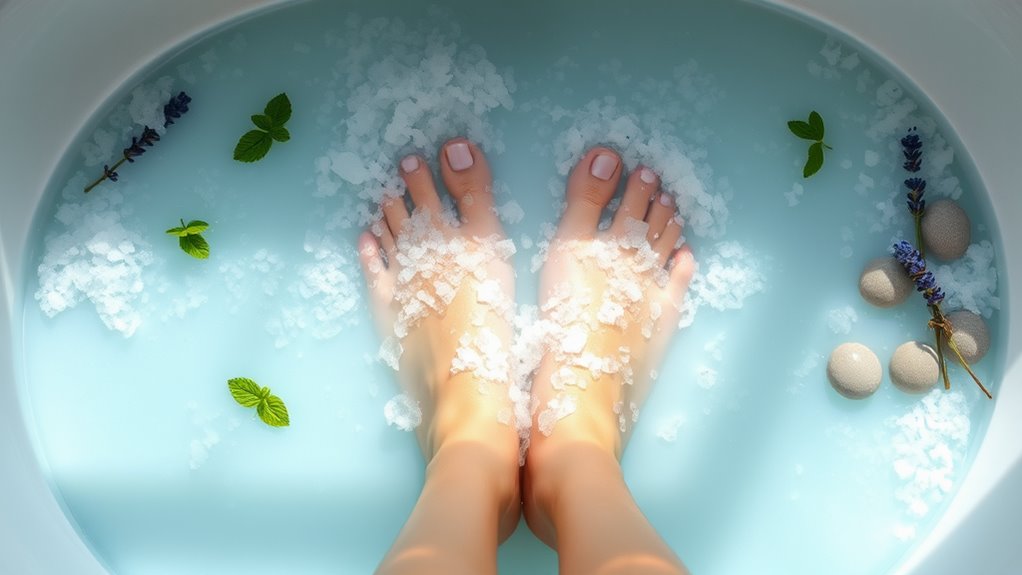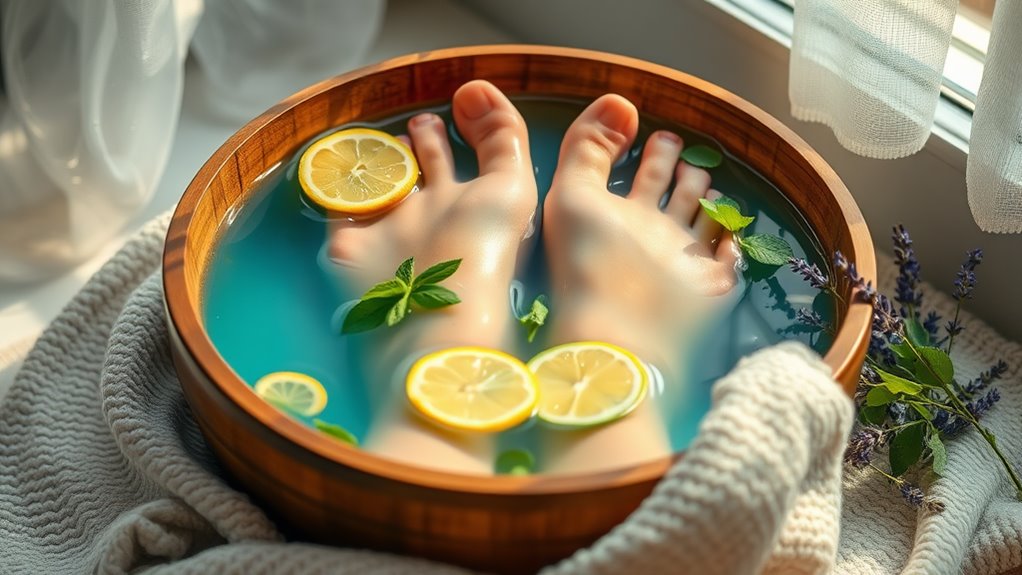Say Goodbye to Puffy Feet With These Home Remedies
If you’ve been struggling with puffy feet, you’re not alone. Many people experience swelling due to factors like poor circulation, long hours on their feet, or a high-sodium diet. Fortunately, there are simple home remedies that can help alleviate this discomfort. From elevating your feet to incorporating specific dietary changes, you can find relief. Want to learn the most effective strategies to say goodbye to that puffiness? Let’s explore them together.
Key Takeaways
- Elevate your feet on a pillow or chair to improve circulation and reduce swelling.
- Apply cold compresses to your feet for 15-20 minutes to alleviate inflammation and enhance blood flow.
- Incorporate herbal remedies like dandelion and ginger to naturally reduce fluid retention and improve circulation.
- Stay hydrated by drinking water and eating water-rich foods to help flush out excess sodium.
- Limit salt intake and increase potassium-rich foods to combat fluid retention effectively.
Understanding the Causes of Puffy Feet
Have you ever wondered why your feet swell after a long day? This common issue often stems from prolonged standing, which puts pressure on your veins. Poor circulation, fluid retention, or even diet can contribute to this discomfort. Salt intake, for instance, can lead to increased water retention, causing swollen feet. If you’re dealing with puffy feet, consider trying some effective swollen feet remedies. Simple solutions like staying hydrated, reducing salt, and wearing comfortable shoes can make a difference. Understanding these causes helps you tackle the problem more effectively and find relief from that uncomfortable swelling. Additionally, elevation techniques such as propping your feet up can provide immediate relief from swelling.
Elevation Techniques to Reduce Swelling
After understanding the causes of puffy feet, it’s important to explore practical solutions, and elevation techniques can be particularly effective.
By raising your feet, you can help reduce swelling and improve circulation.
Here are three simple techniques you can try:
- Lie down: Prop your feet up on a pillow or cushion while you relax.
- Chair position: Sit in a chair and rest your feet on another chair or table, keeping them elevated.
- Wall support: Lie on your back and elevate your legs against a wall for 15-20 minutes for maximum relief.
Incorporate these techniques into your routine! Additionally, maintaining each position long enough can significantly enhance the effectiveness of these methods.
The Benefits of Cold Compresses
Cold compresses are a quick and effective way to reduce inflammation in your feet.
By applying a cold pack, you can also enhance blood circulation, helping to alleviate that uncomfortable swelling.
Let’s explore how this simple remedy can make a noticeable difference in your comfort. Additionally, taking breaks between applications is crucial to prevent skin damage, ensuring you can benefit from this remedy safely.
Reduces Inflammation Quickly
When you want to tackle puffy feet quickly, applying a cold compress can work wonders.
This simple remedy helps reduce inflammation and provides immediate relief.
Here’s how to make the most of it:
- Choose Your Compress: Use a clean cloth soaked in cold water or a bag of ice wrapped in a towel.
- Apply: Position the compress on your feet for 15-20 minutes, allowing the cold to penetrate.
- Repeat: Do this several times a day as needed, especially after long periods of standing or sitting.
You’ll notice less swelling and discomfort, getting you back on your feet in no time!
Enhances Blood Circulation
While many people rely on cold compresses primarily for their anti-inflammatory effects, they also play an essential role in enhancing blood circulation.
When you apply a cold compress to your feet, the cold constricts blood vessels initially, then causes them to dilate once removed.
This process encourages increased blood flow, helping to reduce swelling and improve overall circulation.
Regular use can promote healthier feet, preventing discomfort and fatigue.
Plus, it’s a simple, cost-effective remedy you can do at home.
Just remember to wrap ice in a cloth to protect your skin, and enjoy the soothing relief that follows.
Herbal Remedies for Foot Swelling
If you’re looking for natural ways to reduce foot swelling, herbal remedies can be quite effective. Certain herbs act as diuretics, helping your body eliminate excess fluid, while others have anti-inflammatory properties that can ease discomfort. Incorporating these herbs into your routine might just give you the relief you need. Additionally, consider increasing your intake of potassium-rich foods to help balance your body’s water retention.
Natural Diuretics
Natural diuretics can be a game-changer for reducing foot swelling.
These herbal remedies help your body eliminate excess fluid, providing relief and comfort.
Here are three effective options to try:
- Dandelion: This common weed boosts urination and is high in potassium, balancing electrolytes.
- Horsetail: Known for its anti-inflammatory properties, it promotes urine production and supports kidney function.
- Green tea: Packed with antioxidants, it acts as a gentle diuretic while enhancing overall health.
Incorporating these natural diuretics into your routine can help you say goodbye to puffy feet and feel revitalized!
Anti-Inflammatory Herbs
When it comes to tackling foot swelling, incorporating anti-inflammatory herbs into your routine can make a significant difference.
Turmeric is a powerful option; its active compound, curcumin, helps reduce inflammation.
Ginger is another fantastic choice, known for its ability to improve circulation and ease swelling.
You can try adding these herbs to your meals or sipping them as teas.
Other notable herbs include cayenne pepper, which boosts blood flow, and rosemary, known for its anti-inflammatory properties.
By using these herbal remedies, you’ll not only soothe your feet but also enhance your overall well-being.
Give them a shot!
Staying Hydrated: The Key to Reducing Puffiness
Staying hydrated is essential for keeping your feet feeling light and reducing puffiness.
When you’re well-hydrated, your body can effectively flush out excess sodium, which often contributes to swelling.
Here are three simple ways to boost your hydration:
- Drink Water Regularly: Aim for at least eight 8-ounce glasses daily to maintain ideal hydration.
- Eat Water-Rich Foods: Incorporate fruits and vegetables like cucumbers, watermelon, and oranges into your diet.
- Limit Caffeine and Alcohol: These can dehydrate you, so enjoy them in moderation. Additionally, staying hydrated can enhance your body’s ability to reduce fluid retention, which is a key factor in minimizing swelling.
Exercises to Improve Circulation in Your Feet
Engaging in regular foot exercises boosts blood flow and reduces puffiness. Start with ankle circles; rotate your feet clockwise and counterclockwise for a minute each. Next, try toe raises—stand on your tiptoes, hold for a few seconds, then lower. Finally, stretch your calves by leaning against a wall with one foot behind the other. These exercises enhance circulation and strengthen muscles, promoting better overall foot health. Incorporate them into your daily routine, and you’ll feel more energized while minimizing swelling in your feet. Additionally, gentle massage can also significantly improve circulation in your feet.
Dietary Changes to Combat Fluid Retention
Here are three adjustments you can make:
- Reduce Sodium Intake: High salt consumption can lead to water retention. Try seasoning with herbs instead.
- Increase Potassium-Rich Foods: Foods like bananas, avocados, and spinach help balance sodium levels and reduce fluid buildup.
- Stay Hydrated: Drinking enough water encourages your body to release excess fluids rather than hold onto them. Additionally, maintaining adequate hydration aids in efficient food breakdown and digestion.



